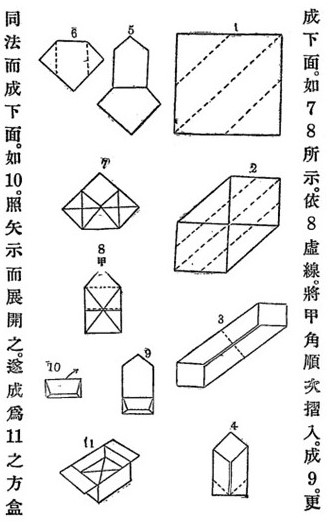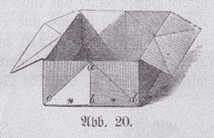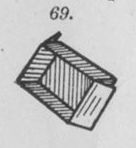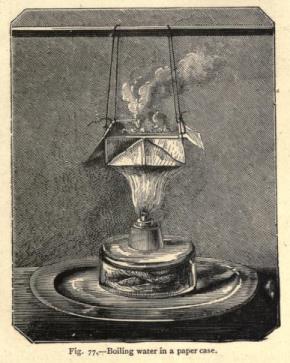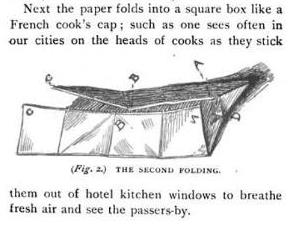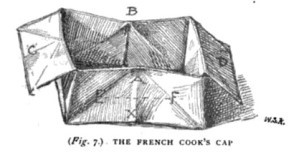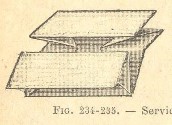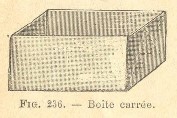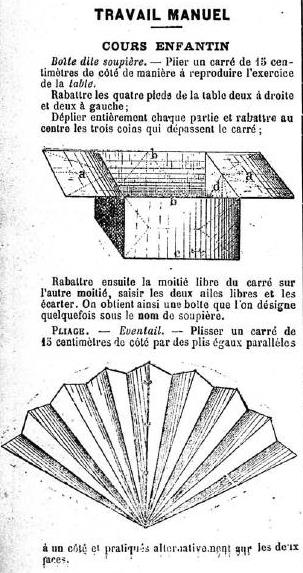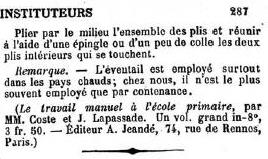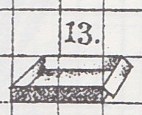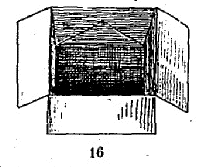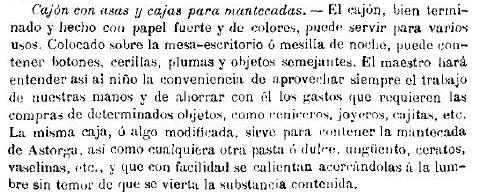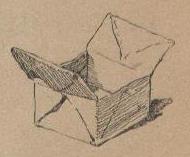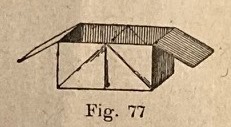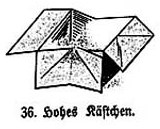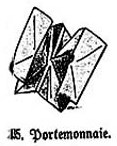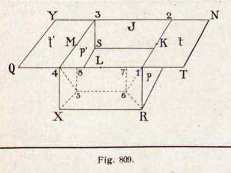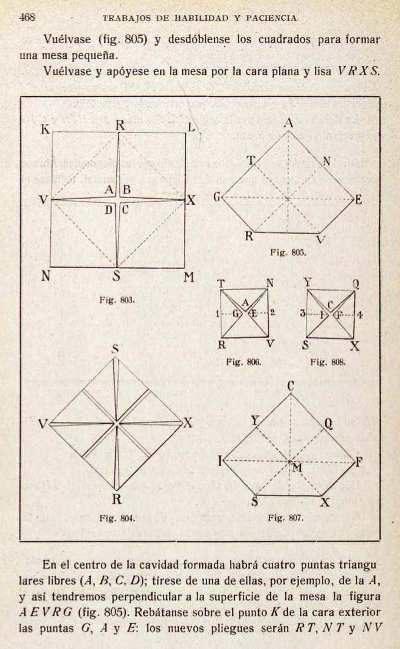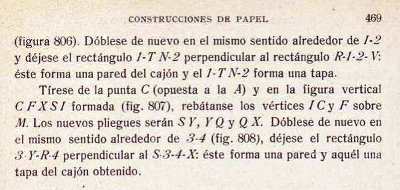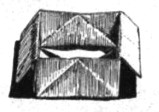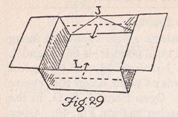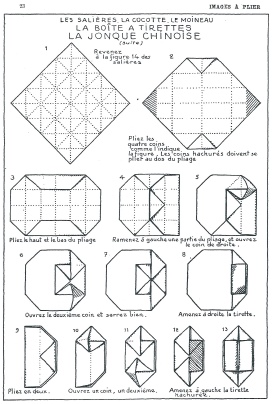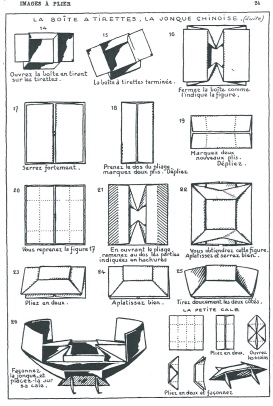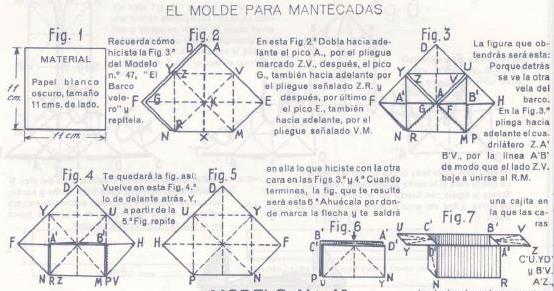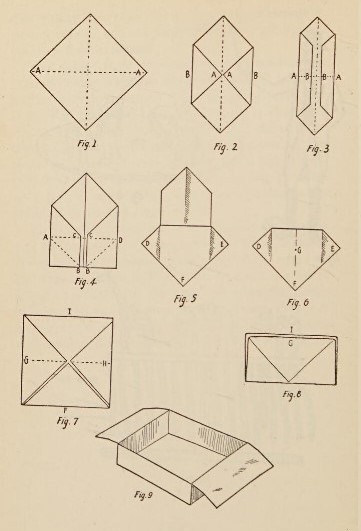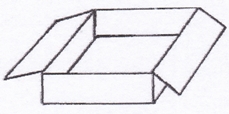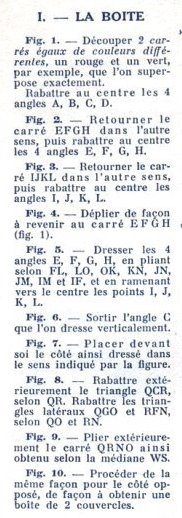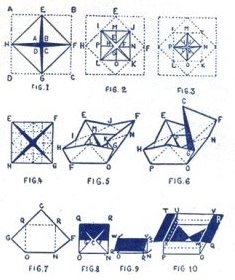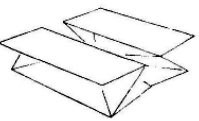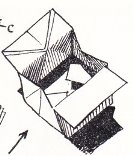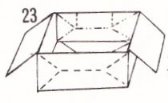| The Public Paperfolding History Project
Last updated 10/12/2025 x |
|||||||
| The Junk Box | |||||||
| This
page is being used to collect information about the
history of the design I call the Junk Box (because it is
part of the folding sequence which culminates in the
Chinese Junk). The Junk Box does, however, sometimes also
appear as a design in its own right. Please contact me if
you know any of this information is incorrect or if you
have any other information that should be added. Thank
you. The Junk Box is a form of the Basic Box made from a doubly blintzed square. This page also includes instances where a collapsed form of the Junk Box is viewed as a purse / portfolio and as a hat and where a handle has been added to turn the design into a basket. ********** In China (and in publications by Chinese authors) 1917 The design appears as 'Square Box with Ears' in 'Xu Zhe zhi tu shuo' (More Illustrated Paperfolding) by Yongxiang Shi, which was published by the Commercial Press in Shanghai in 1917.
********** 1934 The design appears as 'Paper Tray' in 'Zhezhi Xinfa' (New Ways to Fold Paper), which was published by The Commercial Press in China in 1934.
********** In Europe and the Americas 1859 The Junk Box first appears, as simply 'La boite' or 'the box' in a list of designs in the 'Manuel Pratique de Jardins D'Enfants de Friedrich Froebel', which was compiled by J F Jacobs and published in Brussells and Paris in 1859 as part of the folding sequence that culminates in the Chinese Junk. ********** 1863 'De Kleine Papierwerkers 1: Wat men van een stukje papier al maken kan: Het vouwen' (The Small Paperwork 1: What one can make from a piece of paper: Folding) by Elise Van Calcar, which was published by K H Schadd in Amsterdam in 1863, contains a reference to a design described as a 'zakje met twee taschjes' (box with two handles) which, in the context, must be the Junk Box. (see also entry for 1875 below). ********** 1873 There is reference to 'La boite a double couvercle' (the box with two lids) in a list of designs in 'Exercices et Travaux pour les Enfants Selon la Méthode et les Procédés de Pestalozzi et de Froebel' by Fanny and Charles Delon, which was published by Librairie Hachette in Paris in 1873. Unfortunately there is no illustration to confirm the identification of the design. ********** The Junk Box also appears: As 'Kasten' in 'Die Praxis Des Kindergartens' by August Koehler, which was published by Herman Bohlau in Weimar in 1873.
********** 1875 As 'Het aschbakje' (the ashtray) in 'Froebels Methode' by Elise Van Calcar, which was published in 1875. Note that in the illustration the handles are not visible since they are folded down. The context makes clear, however, that the design in question is the Junk Box.
********** 1876 In 'Des Kindes Erste Beschaftigungsbuch' by E Barth and W Niederley, which was first published in Bielefeld and Leipzig, and the foreword of which is dated October 1876.
********** 1887 As 'Boite dite soupiere' (box called a soup tureen) in 'Le Travail Manuel a L'ecole Primaire' by M. Coste et J. Lapassade, which was published by Lafon, Vve Ribaut et Tonnet in Pau and A Jeande in Paris in 1887.
********** 1880 In 'Maakt de Kinderen Gelukkig' by Elise Van Calcar, which was published by H C Van Calcar in Gravenhage in 1880, there is a probable reference to this design as 'het bakje' (the box), although no illustration is provided. ********** In 'The Kindergarten Principle' by Mary J Lyschinska, published in London in 1880 by Wm Isbister Ltd, as just 'The Box'.
********** An illustration of a Junk Box used as a paper pan to boil water in (Ebullition de l’eau dans un vase en papier) was published in 'La Nature' 370 of July 3rd, 1880 on p. 71-72, in an article headed 'Les Physiques Sans Appareils' written by Gaston Tissandier. The box is described as 'une petite boite rectangulaire, comme les ecoliers savent en confectionner' or, in English, 'a small rectangular box, which schoolchildren know how to make'. It was subsequently included in the 1883 3rd Edition of Gaston Tissandier's 'Les Recreations Scientifique' and was probably also included in the 1880 1st and 1881 2nd editions.
********** 1882 In 'Part two of 'The Kindergarten Guide' by Maria Kraus Boelte and John Kraus, probably first published by E. Steiger and Company in New York in 1882, as 'The Square Box Having Two 'Lids'.
********** 1883 An illustration of a Junk Box used as a paper pan to boil water in appears in 'Recreaciones científicas ó la física y la química sin aparatos ni laboratorio y solo por los juegos de la infancia' by Gaston Tissandier, a Spanish translation of 'Les Recreations Scientifique', which was published in Madrid in 1883.
********** The same illustration also appears in the English language version, 'Popular Scientific Recreations', which was published by Ward, Lock and Co Ltd in London and New York, also in 1883.
********** The Junk Box also appears in a pictorial story by Apeles Mestres dated 2nd August 1883 found in his Llibre Vert III.
********** 1884 The Junk Box is illustrated in 'Jeux et Jouets du Jeune Age' by Gaston Tissandier, which was published by G Masson in Paris in 1884, but no folding instructions are given.
********** 1888 The Junk Box apperas as 'French cook's cap' in 'Wide Awake: Volume Z', which was published by D Lothrop Company in Boston in 1888.
********** 1889 As 'Boite en papier pour servir des fruits a la campagne' (Paper box for serving country fruits) in 'La Science Pratique' by Gaston Tissandier, which was published by G Masson in Paris in 1889.
********** 'La Nature' of 28th September 1889 contained an article headed 'Recreation Scientifiques' and subheaded 'La Grenouille Japonaise en Papier' (The Japanese Paper Frog) which includes the words (here in translation) 'In France, it is true, we also know the charming game of folding paper. The classic Cocotte, the box and the galiote etc., are popular here but we must agree that the Japanese have more ingenious models.' The box mentioned here is most probably the Junk Box. ********** 1890 Diagrams for 'Une corbeille carré' (a square basket) appear in 'Les travaux manuels a l'ecole primaire a l'usage des ecoles de garcons' by Dauzat and Deramond, which was published by Alcide, Picard et Kaan in Paris in 1890.
********** The Junk Box Basket appears as 'Panier' in 'Le travail manuel a l'ecole et dans la famille' by MM, Bertrand, Toussaint and Gombert, which was published by Loucene, Oudin et ces Editeurs in Paris in 1890.
********** 1891 In 'Pleasant Work for Busy Fingers' by Maggie Browne, which was published by Cassell and Company in London in 1891. This book is an English version of 'Des Kindes Erste Beschaftigungsbuch' enhanced by the addition of a few extra designs. ********** 1893 As 'Serviette D'Avocat' (Lawyer's Box) and 'Boite Carree et Panier a Double Couvercle' (Square Box and Basket with Double Lid) in 'L'Annee Preparatoire de Travail Manuel' by M P Martin, which was published by Armand Collin & Cie in Paris in 1893.
********** As 'Boite dile soupiere' (Soup tureen box) in the 30th April 1983 issue of 'Journal des Instituteurs'. This is extracted from the book 'Le Travail Manuel a L'ecole Primaire', by M. Coste et J. Lapassade, which had been published in 1887.
********** 1895 As a hat in an article 'A Paper Bird, a Double Boat and a Workshop Hat' by Burnett Fallow in the 'The Boy's Own Paper' of 2nd November 1895.
********** As 'A Box with Lid' in 'Course of Paperfolding' by Eleonore Heerwart, which was published by Charles and Dible in London and Glasgow in 1895.
********** 1899 In 'Le Livre des Amusettes' by Toto was published in Paris by Charles Mendel in 1899. It is not developed into the Chinese Junk in this book.
********** 1903 Under the title of 'boite a bonbons' in an article by Alber in the French children's magazine Mon Journal of 6th June 1903.
********** 1902 As 'Caja sin Tapa' in 'Guia Practica del Trabajo Manual Educativo' by Ezequiel Solana, which was published by Editorial Magisterio Español in Madrid in 1902.
********** As 'Quadratische Schachtel' in 'Handbüchlein der Papierfaltekunst' (Handbook of Paperfolding Art) by J Sperl, which was first published by by H Hartleben's Verlag in Wien and Leipzig in 1904.
********** 1907 As 'Cajon con asas y caja para mantecadas' (Drawer with handles and box for shortbread)in an article titled 'El trabajo manual escolar' by Vicente Casto Legua in the January 1907 issue of the Spanish magazine 'La Escuela Moderna' which was published in Madrid by Los Sucesores de Hernando. No illustration of this design is given but from the text these boxes appear to be versions of the Junk Box with and without handles. The notes about these designs in the following month's issue say:
Roughly translated the last sentence says, 'The same box, or slightly modified, serves to contain the mantecada of Astorga, as well as to hold other pastes or sweets, ointments, waxes, vaseline etc and to allow them to be heated on the fire without fear of spilling the contents.' ********** 1908 In the last ever issue of the Catalan satirical magazine 'La Campana Catalana', published in Barcelona on 29th April 1908, in a cartoon by Apeles Mestres which pictures a variety of paperfolding designs. This pictorial story had previously been published in his Llibre Vert III in 1883.
********** As 'Boite a bonbons' in 'Les Petits Secrets Amusants' by Alber-Graves, which was published by Librairie Hachette in Paris in 1908.
********** 1910 As 'Hohes Kästchen' (height box) in Part 2 'Das Flechten' of 'Die Frobelschen Beschaftigungen' by Marie Muller-Wunderlich, which was published by Friedrich Brandstetter in Leipzig in 1910.
*** The same book contains a design for a 'Portemonnaie' (coin wallet) which is simply the Junk Box squashed flat.
********** As 'Kasten mit Deckel' (Box with Lid) in 'Allerlei Papierarbeiten' by Hildergard Gierke and Alice Kuczynski, which was published by Drud und Verlag B G Teubner in Leipzig and Berlin in 1910.
********** As 'A Box' in 'Handicraft in the School', which was issued in four volumes by Gresham Publishing in London in 1910.
********** 1913 As 'Canastilla prismatica con aro de broches' in 'Trabajo Manual' by C Champy Alvear, which was published by Cabaut y Cia in Buenos Aires in 1913. These diagrams show a very complicated method of making this simple box. The design is then turned into a basket with the addition of a simple handle.
********** 1918 As 'Cajon con tapas' in 'Ciencia Recreativa' by Jose Estralella, which was published by Gustavo Gili in Barcelona in 1918.
********** As 'La Cajita' in 'Juguetes de Papel', which was published by Editorial Muntanola in Barcelona inn 1918. This version appears to be folded from a triply blintzed square.
********** 1920 In 'Paper Magic' by Will Blyth, which was first published by C Arthur Pearson in London in 1920, as 'The Pin Tray'.
********** 1923 As 'Rechtechige Schachtel' (Rectangular Box) in 'Falten und Formen mit Papier' by Richard Rothe which was published by Deutscher Verlag für Jugend und Volk in Vienna and Leipzig in 1923.
********** 1928 'In 'Fun with Paperfolding' by William D Murray and Francis J Rigney, which was published by the Fleming H Revell Company, New York in 1928, and which contains a picture of the Junk Box, although it is treated as just an intermediate form rather than a design in its own right.
********** c1929 As 'Caja' in booklet 2 of 'Trabajos Manuales Salvatella - Plegado de figuras de papel', which was published by Editorial Miguel A Salvatera in Barcelona, pobably in or around 1929.
********** 1931 As 'Kasten' in the revised 3rd edition of 'Lustiges Papierfaltbüchlein' by Johanna Huber, which was published by Otto Maier in Ravensburg, Germany in 1931.
The text says that baskets can easily be made from open boxes by glueing on a handle.
********** 1932 In 'Winter Nights Entertainments' by R M Abraham, which was first published by Constable and Constable in London in 1932, under the title of 'A Paper Tray'.
********** In Booklet 2 of 'Images a Plier', a series of 6 booklets published by Librairie Larousse in Paris in 1932.
********** As 'Caja con asas' in Booklet 2 of 'Figuras de Papel', a series of 3 booklets published by B Bauza in Barcelona in 1932. ********** 1939 As 'El molde para mantecadas' (The mold for shortbread) in 'El Mundo de Papel' by Dr Nemesio Montero was published by G Miranda in Edicions Infancia in Valladolid in 1939.
********** 1936 As 'A Paper Tray' in 'More Things Any Boy Can Make' by Joseph Leeming, which was published by D Appleton-Century Company in New York and London in 1936.
********** 1939 As 'A Candy Box' in 'Fun with Paper' by Joseph Leeming, which was published by Spencer Press Inc in Chicago in 1939.
********** 1948 As the 'Small Box' in 'The Art of Chinese Paper folding for Young and Old' by Maying Soong, which was published by Harcourt Brace and Company of New York in 1948.
********** 1951 As 'Boite' in 'Occupons nos doigts' by Raymond Richard which was published by Les Editions du Cep Beaujolais in Villefranche-sur-Rhone in 1951.
********** 1952 As 'Caja' in 'Una Hoja de Papel' by Lorenzo Herrero, which was published by Miguel A Salvatella in Barcelona in 1952.
*** The same book contains a design for a 'Cartera' which is simply the Junk Box squashed flat.
********** 1956 As 'The Water Dish' in 'Paper Magic' by Robert Harbin, which was published by Oldbourne in London in 1956, as part of the 'Multiform' sequence.
********** 1963 As 'Box with Lids' in the second edition of 'Het Grote Vouwboek' by Aart van Breda, which was published by Uitgeverij van Breda in 1963.
********** A stretched version of the design folded from a dollar bill appears in 'The Folding Money Book', which was published by The Ireland Magic Co in Chicago in 1963.
********** 1964 As 'The Container', as part of the Multiform sequence, in 'Secrets of Origami', by Robert Harbin, which was published by Oldbourne Book Company in London in 1964.
********** |
|||||||
